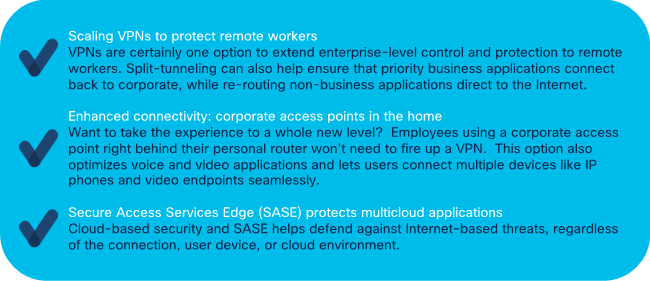Workforce resilience: extending security to remote workers – Cisco Blogs

In this installment of our #2021NetworkingTrends blog series, we discuss Trend #1 – extending security to a remote workforce.
Some events are so disruptive that we’re forced to re-think everything. Often, this is a blessing in disguise. All kinds of innovation springs out of questions like “is there a better way to do this?” and “should we even be doing this at all?”
For instance, many enterprises thought there was absolutely no way their entire workforce could get the job done without coming into the office. In fact, working at Cisco for the last 20 years, I made it a priority of mine to be in the office every working day. But take a look at what happened; in the face of immense change, our employees flourished. Many discovered they got more work done at home than at the office. They benefited from spending more time with their families and less time stressed out from long commutes. In a recent study, “almost 90% would like to continue working from home in some capacity, with almost half wanting to work at home often or all of the time[1].”
Enterprises also felt the benefits with increased employee productivity, reduced OpEx (think empty buildings, no work parties, and no travel), and a newfound appreciation for access to a distributed talent pool.
So, this begs the question: is it time to re-think your enterprise network? Whether or not your organization requires employees to be on the campus, it’s likely that at least some of the time they will need to be able to work remotely. Even from a business resilience perspective, when the next disruptive event occurs, your organization needs the ability to securely extend the enterprise network to the user anywhere.
Sounds easy, right? Just scale up VPN, add a few cloud apps, and let them work from anywhere.
Unfortunately, enabling remote workers brings some new challenges. The remote worker doesn’t always have the same high-quality bandwidth for all of the high-quality, high bandwidth-consuming business applications. They also may not always (how do we say this delicately…) have the best security hygiene. Logging onto untrusted networks, clicking on phishing links, using personal devices, and downloading their own unapproved applications (shadow IT anyone?). Let’s try not to even think about ‘Password1’ scenarios. And just because employees are on a VPN, they may not even realize how much traffic they are creating on the enterprise network by running non-business apps like YouTube, Netflix, Facetime, and Hulu.
In a recent customer survey, it’s the end-user behavior that presents the #2 biggest challenge that IT has to deal with enabling a remote workforce. (Security will always win in that contest.)
From the same survey, carried out in September, 57% of organizations still reported that securing their remote workforce was a top priority, up from 23% prior to the pandemic. That’s five months after the campus exodus in March.

What can be done then? IT must develop strategies to extend secure enterprise network connectivity to remote workers at home and in micro-offices, giving them an enhanced application experience with solutions that can be centrally managed. IT needs to provide remote workers the same level of protection, governance, and performance they have enjoyed in the office.
Here are some of the network requirements for enabling your remote workers to have that secure enterprise-grade experience while working remotely:

Conclusion
When we re-think what it will take to bounce back from any disruption, the employee stands at the heart of it all. Extending the network to wherever users are—while not easy— is the future. After all, the network provides our employees the secure access to applications and data they need with the enterprise-grade network performance they’ve come to expect, whether they are at home or in the office.
[1] https://www.bbc.com/news/uk-wales-53946487
Share:

